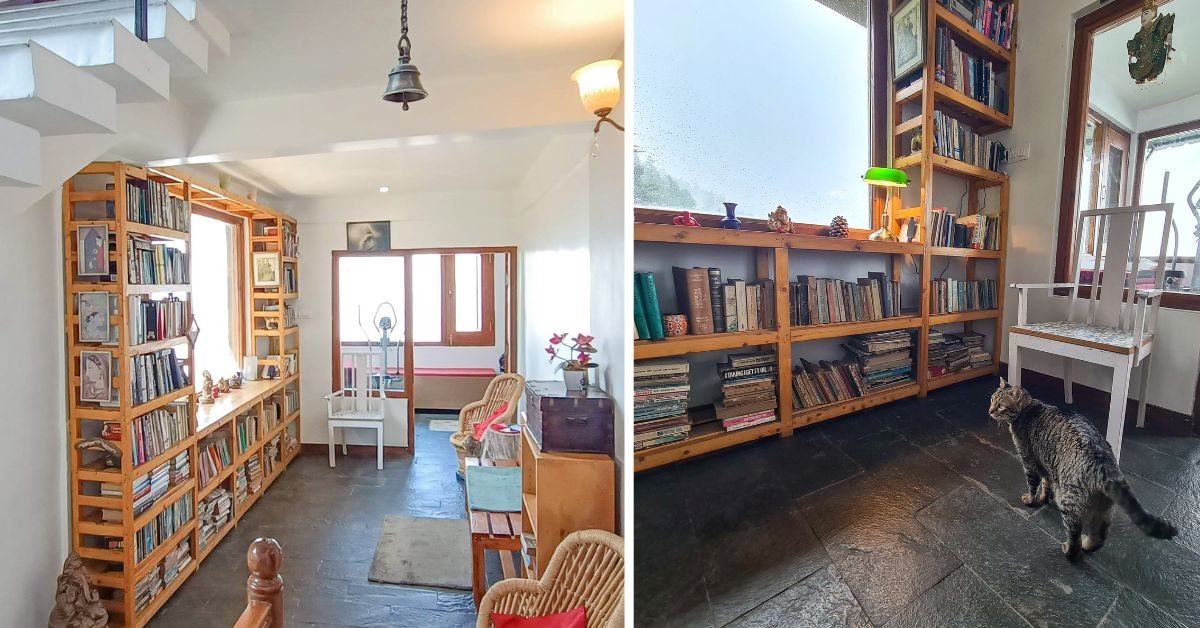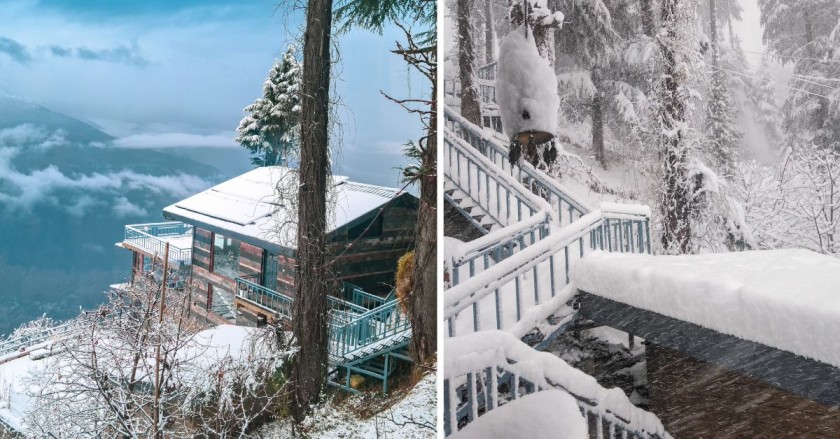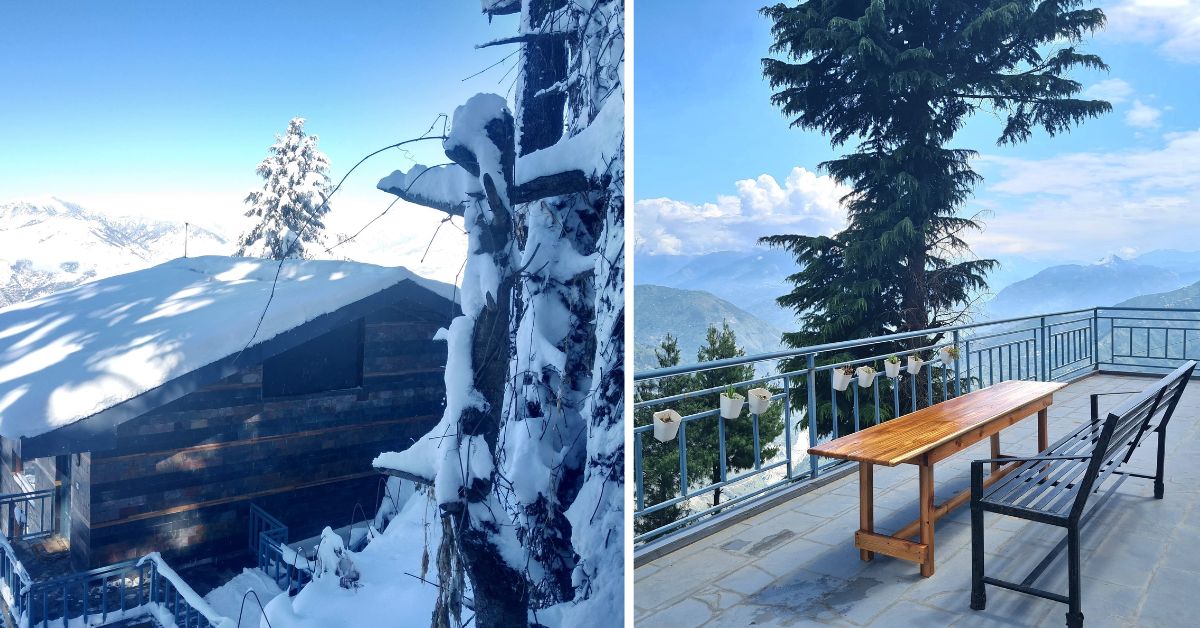For a lot of us, the word “home” is a pandora’s box of memories. From taking our first steps in the familiar hallways of our house to later seeing our child taking their first steps in the home that we built, everything elicits a special response from within.
Our home, thus, becomes the epicentre of memories. A safe landing to fall back to.
Consequently, discovering the ideal location to establish this haven can be an enormous undertaking.
Amid the quest for the right size and location, there’s a distinct sense of eager anticipation and a few heart-fluttering instances when you step into a residence and realize, “This might be the one.”
This precise moment occurred in the lives of Anuradha and Kartik Budhraja when they laid eyes on a piece of land situated in the Saroga village of Himachal Pradesh.
“We were overjoyed upon our initial glimpse of the land. It appeared as though it had been plucked from a fairy tale. We exchanged glances, and in that moment, we both understood that this would be the place where we would nurture our daughters,” reminisces Anuradha Budhraja, when speaking with The Better India.
Long-standing dream of living in the Himalayas
“For us living in the hills, overlooking the Himalayan ranges with nature around us, was our dream. This dream became more urgent when we visited Thanedar in Himachal Pradesh in 2005 to attend a local mela (fair),” recalls Anuradha.

The couple fell in love with the place and wanted to move there. At that time, Anuradha and Kartik were working as media professionals in Singapore.
“The urge to come back to India was mainly for two reasons. Firstly, we both wanted to get out of the rat race and build a business of our own, and secondly, we loved the mountains and nature,” she recalls.
“After a few years of planning and iterating, we decided to finally make the move. We quit our jobs and decided to move to Himachal Pradesh,” she says.
The duo moved to Thanedar and started a fruit jam business utilising the fruits in the area.
“After setting up the factory and settling ourselves in the environment, we really wanted to have a permanent home. By 2017, we were actively looking for a suitable place,” recalls Kartik.
Years later in 2017, at the same annual mela in Thanedar, the couple found their dream home.
“Our girls wanted to set up a stall of our jams in the mela. One of the farmers from Saroga village came up to us and asked why we don’t make cherry jams. Jokingly, he said, ‘if we come to his village he would give us cherries’,” recalls Anuradha.
“In response, I said that we will buy cherries only if he gets us a house in his village. All we know is that the next day, we are driving up to the village, meeting the same farmer again and looking at the land that was to become our home,” adds Anuradha.

Describing the land, Kartik says, “It was everything we had dreamt of. It stood 8000 sq ft above sea level with an amazing view of the Himalayas on one side and the Satluj River on the other.”
The duo decided to purchase the land and hence began the journey of making their dream home.
‘Waking up to the Himalayas in our nature-friendly home’
“The land was only six kilometres from our factory and on three elevations. We decided not to touch the natural beauty of it and instead build our home around it,” he says.
Built on three levels, the house has three bedrooms, three bathrooms, one parlour room and a living room. Along with a dining room and a kitchen, it also has a pantry, a gym, a library and a lounge. The house has its own storeroom, an attic, and quarters for domestic help.
“We did not want to disturb the shape and nature of the land and decided to not level it. The house, if you look at it from the outside, does not look like an eyesore on the beautiful hill. Instead, it blends with nature and actually looks like a part of it,” he says.
The philosophy of the couple behind building the house was simple — they wanted it to be efficient, cosy and nature-friendly.
“My wife and I were the sole designers of the house. We did everything from scratch. We wanted the house to be comfortable and nature-friendly,” he says.

Explaining the various sustainable features of the house, Kartik says, “We studied the area and land very well. We wanted to have a carbon negative, water efficient and climate-resistant home.”
“All the materials used in the house are sourced locally as we wanted to contribute to the local economy. The bricks used in the construction of the house were fly ash bricks. We used them as they have a lesser carbon footprint and are more energy efficient,” he adds.
To keep the house energy efficient, the couple installed solar power in their home. “We have an 8 KW solar plant set up to produce 72 to 80 percent of the power needs of the house. Additionally, we also have a rainwater harvesting plant set up. We catch about 30,000 litres of water in our underground water storage,” he says.
The house also believes in zero waste and has a water filtration system. “All our grey water (the dirty but reusable water from sinks, washing machines) is filtered and is used in cleaning and drinking. Even the wood packaging in which our windows and doors came were used to make some sort of furniture so that nothing goes to waste,” he says.
The house also has double glazing in the windows to keep it warm during the winter.
In their effort to combine traditional and contemporary elements in their home, the Budhrajas acquired all of their wood from a kabadiya (scrap dealer) who sources the wood from dismantled and ageing government and residential structures in Himachal Pradesh.
“We believe in reusing and upcycling. The wood in some of our doors is nearly 100 years old,” informs Anuradha.
“We also used the Himalayan Black State, a type of tile local to the state, for the flooring and cladding of the house. It is a great conductor of heat. We also use electrical heating using solar power to keep the house warm for the harsh winters,” adds Anuradha.
Cladding is a method in which the same tiles are used on the walls of the house from the outside to keep them insulated.
The house also has a kitchen garden where the couple grows their own vegetables such as spinach, white pigweed, herbs such as parsley and wild mint and a few local varieties of kidney beans.
‘Inspiring locals to follow nature-friendly living’
Although the couple wanted to focus on making the house their dream home, they also wanted to spread a strong message.
“There are many ways one can live in harmony with nature, it is all about going the extra mile. Especially with nature, we need to be more careful with the nature around us,” opines Anuradha.
“Straight buildings which are front heavy and rectangular put a lot of pressure on the land which then results in landslides. Therefore, we have made the house into three levels so that we did not have to do any cutting of the land itself,” says Kartik.
“We almost felt selfish to have so much and not share it with others. This is the reason why in 2022, we decided to host a few guests and share this beauty with others too. We started to host a B&B under the name ‘Saroga Woods’,” Anuradha says.
At the B&B, guests have the chance to explore the local village and enjoy jam-making activities with the Budhrajas.
Rana Sidhu, a mountaineer who has lived on the property four times in the past year says, “The hospitality Anuradha and Kartik offer. It is like living in your own home. The property is a marvel of how you can use modern technology to preserve nature. Although the concept of eco-tourism is catching up now, we still have a long way to go. We need people like Anu and Kartik who can very well run a business while living in harmony with nature,” he adds.
The Budhrajas say that with their house they were able to inspire and intrigue people living around the place too.
“We can witness change and people do want to know what techniques we use and how we managed to install the solar panels or rainwater harvesting. We took the help of local contractors and architects to help us make this house a reality. We even have an email ready with all the information to help others adopt these techniques too. Whenever someone shows interest, we readily explain the process and also share our resources with them,” says Anuradha.
If you wish to enjoy a stay at Saroga Woods, you can visit their website and or make bookings at 9816464404.
(Edited by Padmashree Pande)
No comments:
Post a Comment